
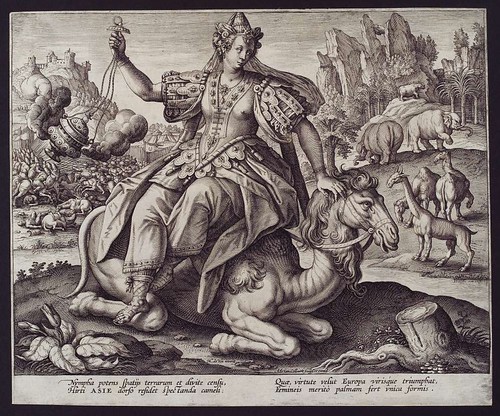

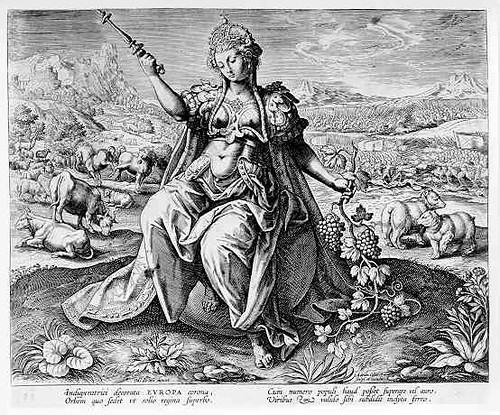
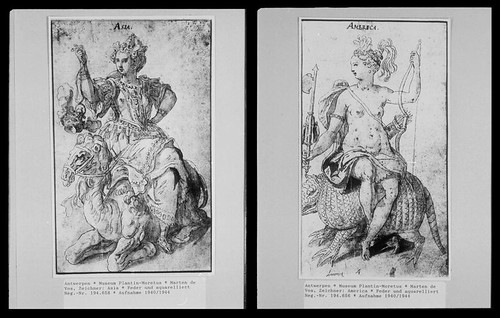
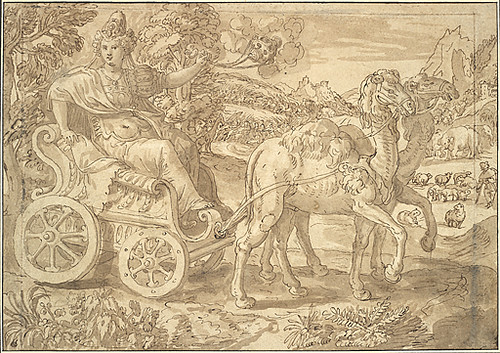
The first three images above come from the collaborative engravings database, Virtuelle Kupferstichkabinett. The fourth is from Ruhr-Universität Bochum. The fifth paired sketch images are from Bildinex and the final inkwash painting is from Harvard University.
The main 'Allegory of the Four Continents' series (we are told "1551-1600" but I think it's actually from the early 1590s) was designed by the Flemish painter/artist, Marten de Vos and engraved by Adriaen Collaert. The paired images are the original design drawings. The inkwash drawing, also by Marten de Vos is for a parallel series (I believe the others are online) of continental allegories, all featuring a carriage as the central motif.
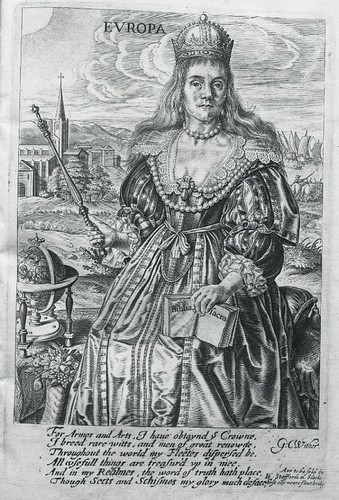
"Europe: a three-quarter-length woman with
crown and sceptre, holding the Bible in her hand"
crown and sceptre, holding the Bible in her hand"

"Asia: a three-quarter-length seated woman with
high turban, holding a book and an incense burner"
high turban, holding a book and an incense burner"

"America: a naked three-quarter-length seated
woman holding a bow and a severed human leg"
woman holding a bow and a severed human leg"

"Africa: a three-quarter-length seated woman
with bare breasts, girdle and armillary"
with bare breasts, girdle and armillary"
This series was published by the London printer John Stafford in 1634. No artist is named and it may well have been Stafford himself, in that the engraving quality is at best fairly mediocre (as was all his own work). From the British Museum.
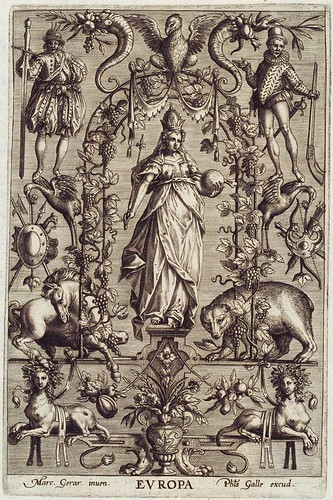

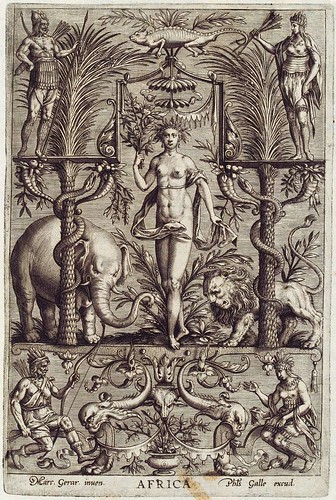
This last series (sans Asia) was engraved by Phillip (Filips) Galle* who was, incidentally, the father-in-law of Adriaen Collaert, the engraver of the first four images in this post. The Galle series was designed by Marcus Gheeraerts (or Geeraerts). The style suggests to me that it was Gheeraerts the Elder (seen previously in relation to his Fables) and not his son. The date is again simply given as 1551-1600 but I'm fairly sure this, too, was produced in the last decade of the 16th century. The images are also from the Virtuelle Kupferstichkabinett.
In late 16th century Europe, an iconographic genre emerged to give a visual face to the changes in geography and knowledge that flowed from colonial expansionist discoveries. As accounts of the New World reached Europe, artists responded by incorporating symbolic motifs of cannibalism, exotic fauna and stylised natives into their works to evoke a sense of barbarism and danger.
Having four continents in the world suited a certain ordered sensibility, reflecting the four cardinal points, the four classical elements, the four seasons and the four virtues (prudence, fortitude, justice and temperance). And of course, the allegorical depiction of the four continents allowed a spirit of superiority to be rendered with, for example, Europe clutching an orb and sceptre astride the globe (a little difficult to see in the fourth image), taking her rightful place as the abundant and dominant force in the world.
I'm unsure how far this theme - allegorical continents - stretches. It's a difficult subject to pin down in searching. Certainly it appears to have started with the mannerist artists of Northern Europe - the elongated bodies, allegorical motifs and 'busy' scenes - but aspects of the style would play out as emblems on maps, as representations in sculptures and paintings and, for instance, in the newly emerging travel book genre of Theodore de Bry (and others). Variations on the theme seem to have been reinterpreted through both the Baroque and Rococo periods. In any event, the main initial players were Crispin de Passe, Jan van der Straet (Stradanus), Philip Galle, Adriaen Collaert, Jan Sadeler, Marcus Gheeraerts and Marten de Vos (in Marten de Vos's case, I get a strong feeling that his design approach was heavily influenced by his one-time tutor, Frans Floris - see the images posted by misteraitch in 'Cort’s and Floris’s Virtues').
And what would they have done with Australia I wonder? A kangaroo, surely, would be the vehicle rather than alligator or camel. Perhaps there would be handcuffs, surfboard wax, Uluru and a fosters beer can folded into the background?
Nothing I've seen online is worthy of linking, although there are more than a few books about of course that touch on the general subject of continental representation and the evolution of the geo-iconographic forms in early modern history.















 Founded in the 11th century as a lay religious order of hospital workers who observed vows of poverty, chastity and obedience in Jerusalem, the Knights of Malta (variously known as: Hospitallers of St. John of Jerusalem; the Soverign Military Hospitaller Order of St John of Jerusalem of Rhodes and of Malta; the Order of St John of Jerusalem and similar permutations) were contemporaries with the more military inclined Knights Templar, and provided care to Christian pilgrims.
Founded in the 11th century as a lay religious order of hospital workers who observed vows of poverty, chastity and obedience in Jerusalem, the Knights of Malta (variously known as: Hospitallers of St. John of Jerusalem; the Soverign Military Hospitaller Order of St John of Jerusalem of Rhodes and of Malta; the Order of St John of Jerusalem and similar permutations) were contemporaries with the more military inclined Knights Templar, and provided care to Christian pilgrims.